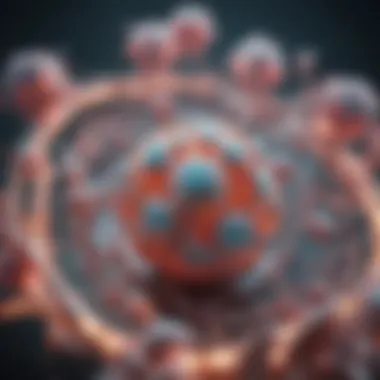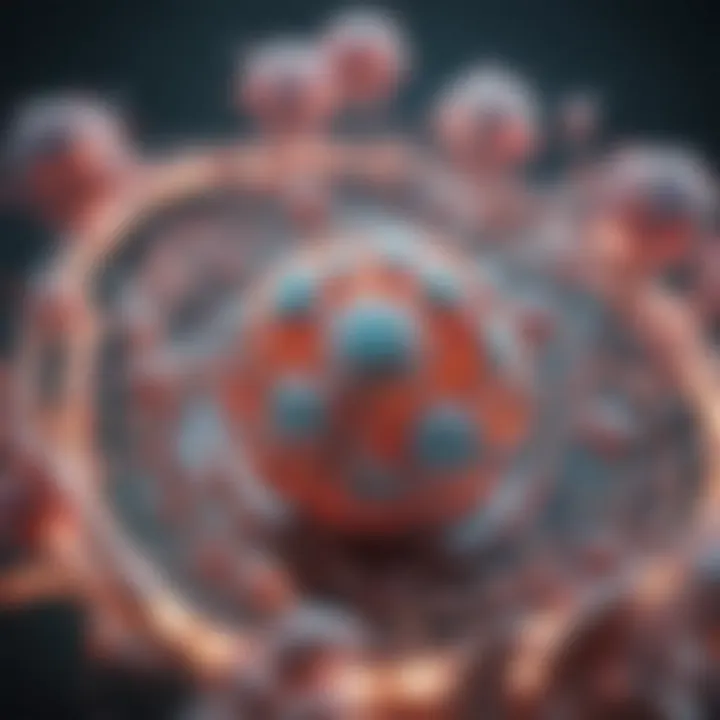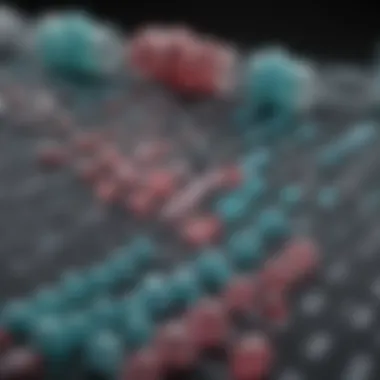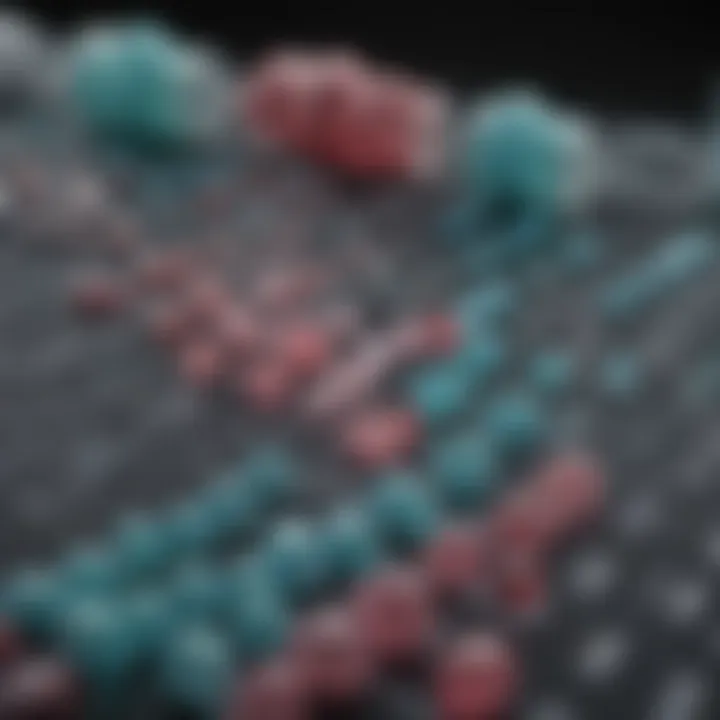Exploring Chemotherapy Options for Ovarian Cancer


Overview of Research Topic
Brief Background and Context
Ovarian cancer represents a significant health concern globally. It is known for its subtle onset, often leading to advanced stages at diagnosis. Chemotherapy has become a cornerstone in the treatment of this malignancy. Typically, it employs cytotoxic agents that target rapidly dividing cells. This method aims to minimize tumor proliferation and spread. The two major types of ovarian cancer are epithelial and non-epithelial, with the former being more common. Understanding the different types of chemotherapy agents tailored for these types is vital for effective treatment.
Importance in Current Scientific Landscape
The landscape of chemotherapy for ovarian cancer is rapidly evolving. With advancements in research, there is a greater emphasis on personalized medicine. Tailoring treatment plans based on individual patient characteristics enhances the effectiveness of therapies. Moreover, emerging agents and combinations are being explored to overcome resistance to traditional chemotherapy. This ongoing research is critical, as many patients experience relapse, necessitating alternative approaches. By understanding these developments, healthcare professionals can make informed decisions to improve patient outcomes.
Chemotherapy Agents for Ovarian Cancer
Chemotherapy typically utilizes several key drugs. These agents can be classified into various categories based on their mechanisms of action. Some important agents include:
- Cisplatin: A platinum-based drug that damages DNA in cancer cells, preventing replication.
- Carboplatin: Similar to cisplatin, but it is often preferred due to its more favorable side effect profile.
- Paclitaxel: A taxane that disrupts microtubule function, leading to cell cycle arrest in cancer cells.
- Docetaxel: Another taxane, also effective against ovarian cancer and often used in combination regimens.
"Chemotherapy is crucial. It fundamentally changes the outcomes for many women diagnosed with ovarian cancer."
Understanding the unique roles of these agents allows clinicians to design more effective treatment protocols.
Emerging Chemotherapy Options
In recent years, newer agents have been developed. These include drugs that target specific molecular pathways or enhance the body's immune response. An example is Niraparib, a PARP inhibitor that exploits the DNA repair weaknesses in cancer cells. These emerging therapies offer hope for patients with resistant strains of ovarian cancer, expanding the treatment arsenal.
Personalized Treatment Approach
Personalized treatment plans are vital in improving chemotherapy outcomes. Considering genetic factors, tumor biomarkers, and patient health can help select the most appropriate agents. For instance, patients with BRCA mutations may benefit more from PARP inhibitors compared to standard chemotherapy.
This tailored approach fosters a more effective response and mitigates unnecessary side effects. Patients often report better quality of life as a result.
Culmination
The field of chemotherapy for ovarian cancer is both complex and evolving. With a better understanding of available agents and their mechanisms, healthcare professionals can more effectively combat this challenging disease. Armed with up-to-date knowledge and personalized treatment strategies, the prognosis for ovarian cancer patients is slowly improving. Embracing ongoing research is essential to advance treatment and ultimately improve patient outcomes.
Prelude to Ovarian Cancer Chemotherapy
The treatment of ovarian cancer is a complex and multifaceted process. Chemotherapy plays a critical role in managing this disease. It is essential to understand the specific types of chemotherapy used in ovarian cancer to assess the benefits and potential risks associated with each treatment plan. In this section, we will explore the fundamentals of chemotherapy, its mechanisms of action, and its significance in the context of ovarian cancer.
Understanding Ovarian Cancer
Ovarian cancer originates in the ovaries, organs responsible for producing eggs and hormones. It is often termed a silent killer due to its subtle symptoms which can be mistaken for other conditions. This invisibility often leads to late-stage diagnosis, complicating treatment options. Some common symptoms include abdominal bloating, pelvic pain, and frequent urination. The ovarian tissue can develop multiple forms of tumors, categorized as epithelial, germ cell, and stromal tumors. Epithelial ovarian cancer, by far the most prevalent, requires urgent and effective treatment strategies for the best outcomes.
The stages of ovarian cancer range from Stage I, which is localized to the ovaries, to Stage IV, where cancer has spread to distant organs. As the disease progresses, the complexity of treatment increases. Furthermore, factors like a patient's age, health status, and biomarker presence can alter treatment options significantly. Thus, understanding the nature of ovarian cancer can guide therapeutic decisions and shape patient outcomes.
Role of Chemotherapy in Treatment
Chemotherapy serves as a cornerstone in the treatment of ovarian cancer. It is primarily utilized to kill cancer cells, especially after surgical interventions. The goal is to eliminate any remaining malignant cells, reduce tumor size, and manage symptoms associated with advanced cancer. This treatment may be administered before surgery, referred to as neoadjuvant chemotherapy, or after, known as adjuvant chemotherapy.
The selection of chemotherapy drugs depends on various factors, including cancer stage and patient-specific characteristics. Traditional chemotherapy agents consist of platinum-based compounds, such as cisplatin and carboplatin, and taxanes like paclitaxel. These agents work in distinct mechanisms. Platinum drugs form cross-links within the DNA, disrupting the cancer cell’s ability to divide and grow. Taxanes prevent the normal breakdown of microtubules during cell division, leading to cell death.
For optimal treatment effectiveness, it is vital to consider the individual patient’s unique health scenario. This personalization of treatments is increasingly recognized in contemporary oncology.
When designing a chemotherapy regimen, it is crucial to take into account both the biological behavior of the cancer and the patient’s overall health condition.
Overview of Chemotherapy
Chemotherapy plays a crucial role in the treatment of ovarian cancer, serving as a cornerstone for managing this complex disease. The ability to systematically target and kill rapidly dividing cancer cells allows chemotherapy to alleviate symptoms, prolong survival, and sometimes contribute to a cure. It is important to understand the distinct categories and various mechanisms employed by chemotherapeutic agents, as this knowledge directly influences treatment decisions and patient outcomes.
Definition and Purpose
Chemotherapy refers to the use of specific chemicals or drugs to target and destroy cancer cells. The purpose of chemotherapy in ovarian cancer is multi-faceted. It can:
- Shrink Tumors: Large tumors can be reduced in size before surgical intervention, making removal easier and more effective.
- Eliminate Micrometastases: Chemotherapy can address small clusters of cancer cells that may have spread beyond the primary tumor site, thereby decreasing the risk of recurrence.
- Prevent Progression: By hindering cell division and growth, chemotherapy aims to slow the advancement of the disease, offering patients more time to manage their health.


The administration of chemotherapy can occur following surgery, termed adjuvant therapy, or as primary treatment in cases of advanced disease.
Mechanisms of Action
The effectiveness of chemotherapy hinges on its ability to disrupt the life cycle of cancer cells. Various classes of chemotherapeutic agents work through different mechanisms. Here are three primary pathways:
- Alkylation of DNA: Alkylating agents, for example, carboplatin and cisplatin, bind to DNA strands and hinder their ability to replicate. This triggers cell death during the division process.
- Inhibition of DNA Synthesis: Antimetabolites, such as gemcitabine, simulate essential building blocks for DNA and RNA. When incorporated, they mislead the cancer cells in their ability to grow and reproduce, effectively stunting their development.
- Natural Product Mechanisms: Some drugs, like paclitaxel, target the structures within the cell responsible for division. By stabilizing microtubules, these agents prevent normal cell cycle progression, leading to cell death.
Understanding these intricate mechanisms is vital. It emphasizes the need for tailored approaches in chemotherapy treatment plans, aimed at achieving optimal results based on individual patient profiles and tumor characteristics.
The impact of chemotherapy on ovarian cancer treatment underscores the importance of continued research and clinical trials to enhance and refine therapeutic strategies, ultimately aiming for highly effective, personalized treatment plans.
Types of Chemotherapy Drugs
Chemotherapy for ovarian cancer comprises a diverse array of drugs that work through various mechanisms to target cancer cells. Each type of chemotherapy drug plays a crucial role in the overall treatment strategy. Understanding these drugs aids in revealing their specific benefits and limitations, which is fundamental for tailoring effective treatment regimens. This section discusses four primary categories: alkylating agents, antimetabolites, natural products, and platinum-based drugs. Their roles in fighting ovarian cancer, alongside considerations for their use, will be examined in detail.
Alkylating Agents
Alkylating agents are significant in the chemotherapy landscape for ovarian cancer. These drugs work by directly damaging the DNA of cancer cells, which inhibits their ability to reproduce. Commonly used alkylating agents include cyclophosphamide and ifosfamide. Their effectiveness lies in the way they interfere with the cell's reproductive process, leading to cell death.
Patients may receive these drugs in various forms, including oral and intravenous administration. Still, their use requires monitoring due to potential side effects. These may include nausea, vomiting, and impacts on blood cell counts. The dosage and timing of administration are also critical, as they can influence efficacy and toxicity. Despite these considerations, alkylating agents remain a foundational component of ovarian cancer treatment protocols.
Antimetabolites
Antimetabolites serve a distinct role in targeting the metabolic pathways essential for cancer cell proliferation. They incorporate themselves into DNA synthesis, leading to disruptions that prevent cell division. Common antimetabolites used in ovarian cancer treatment are gemcitabine and methotrexate. These drugs act mainly during the S phase of the cell cycle when DNA replication occurs.
Although antimetabolites are potent against ovarian cancer cells, their application often comes with side effects. Patients might experience fatigue, gastrointestinal disturbances, and increased susceptibility to infections due to impacts on the immune system. However, careful management and supportive care can mitigate some of these side effects, allowing for effective treatment.
Natural Products
Natural products derived from plants and other organisms are essential as chemotherapy agents. These include taxanes like paclitaxel. These drugs work by disrupting the normal function of the microtubules, which are crucial for cell division. The use of paclitaxel, particularly in combination with other agents, has shown positive outcomes in improving response rates in ovarian cancer.
The administration of natural products can be accompanied by side effects, such as neuropathy, allergic reactions, and potential hair loss. Each patient's reaction can vary widely, making monitoring and adjustments necessary. Natural products bring unique mechanisms that complement the effects of other drugs in combination therapy, enhancing overall effectiveness.
Platinum-Based Drugs
Platinum-based drugs, notably cisplatin and carboplatin, are pivotal in the treatment of ovarian cancer. They interact with DNA, creating cross-links that prevent replication and lead to cell death. Their universal application in treatment regimens has made them a standard therapy for patients with advanced ovarian cancer.
Side effects from platinum-based drugs can include nephrotoxicity, neurotoxicity, and gastrointestinal disturbances. Dosing regimens often require adjustment based on renal function and previous responses to treatment. Despite the risks, the effectiveness of platinum drugs has established them as a cornerstone in chemotherapy for ovarian cancer.
"Platinum-based drugs have radically transformed the prognosis for ovarian cancer patients, especially in advanced stages."
Each type of chemotherapy drug offers different mechanisms and responses, influencing treatment plans significantly. Analyses of these drugs deepen understanding and enable healthcare providers to make informed decisions on the best therapeutic approaches tailored to individual patient needs.
Commonly Used Chemotherapy Regimens for Ovarian Cancer
Chemotherapy regimens are essential in treating ovarian cancer. They can directly influence the success of patient outcomes. Understanding these commonly used regimens enables healthcare professionals and patients to make informed decisions about treatment strategies. Each regimen has specific benefits and consideration that can have a significant impact on the patient's quality of life and overall prognosis.
Carboplatin and Paclitaxel Combination
The combination of Carboplatin and Paclitaxel, often referred to as the standard regimen, is widely utilized in ovarian cancer treatment. This pairing is effective because it targets cancer cells at different phases of their life cycle.
- Carboplatin: This drug belongs to the platinum-based class of chemotherapy. It works by damaging the DNA of cancer cells, making it harder for them to reproduce. It is considered effective in inducing remission in many patients, especially those with advanced stage cancer.
- Paclitaxel: This is an antitumor agent derived from the Pacific yew tree. It inhibits cell division by stabilizing microtubules, which are essential for cell structure and replication. This action effectively slows down or stops the growth of cancer cells.
The combination enhances effectiveness. Many studies show that patients treated with Carboplatin and Paclitaxel experience better outcomes compared to those on single-agent therapy. However, side effects such as nausea, hair loss, and fatigue are common and need to be managed well.
Intravenous vs. Intraperitoneal Chemotherapy
Chemotherapy can be administered via two primary routes: Intravenous (IV) and Intraperitoneal (IP). Each method has unique implications for treatment outcomes and patient comfort.
- Intravenous Chemotherapy: This approach delivers drugs directly into the bloodstream. It is the most traditional method and is effective for systemic treatment, allowing drugs to circulate throughout the body. Patients generally find this option more comfortable, but it may lead to less localized delivery of the drugs to the cancer cells within the abdomen.
- Intraperitoneal Chemotherapy: This method involves administering chemotherapy directly into the peritoneal cavity. Studies have suggested that this approach allows higher concentrations of drugs to target cancer cells located in the abdominal cavity. Patients undergoing IP chemotherapy may have increased side effects, including abdominal discomfort and decreased overall well-being.
The choice between IV and IP chemotherapy depends on various factors, including the stage of cancer and overall health of the patient. The decision should be made collaboratively between healthcare providers and patients.
Dose-Dense Therapy


Dose-dense therapy refers to administering chemotherapy agents more frequently than standard regimens. The rationale behind this approach is to deliver treatment cycles more quickly, potentially increasing the exposure of cancer cells to chemotherapy.
This regimen is often seen as beneficial for certain patients. Studies have highlighted its potential to improve progression-free survival. However, the side effects can be more intense due to the increased frequency of dosing. This modality requires careful consideration of the patient's health and response to previous treatments.
Ultimately, understanding these regimens enhances the overall management of ovarian cancer treatment pathways. Assessing patient-specific factors will ensure the most effective use of these chemotherapy regimens, fostering improved patient outcomes.
Emerging Chemotherapeutic Agents
In the realm of ovarian cancer treatment, emerging chemotherapeutic agents represent a significant leap forward in clinical practice. They provide new hope to patients who may not respond well to standard therapies. The main goal of these agents is to target the cancer more specifically, which often results in better outcomes and reduced side effects.
Targeted Therapies
Targeted therapies focus on specific molecular targets associated with cancer. Unlike traditional chemotherapy, which indiscriminately affects both cancerous and healthy cells, targeted therapies are designed to hone in on particular pathways or proteins that help tumors grow. For ovarian cancer, several targeted agents have shown promise.
- PARP Inhibitors: These drugs, such as Olaparib and Niraparib, target the PARP enzyme involved in DNA repair. By inhibiting this enzyme, cancer cells with BRCA mutations struggle to repair their damaged DNA, leading to cell death. This makes PARP inhibitors especially effective in certain genetic profiles of ovarian cancer.
- Anti-angiogenic Agents: Agents like Bevacizumab inhibit the formation of new blood vessels that tumors need to grow. By starving tumors of their blood supply, these medications can slow down or sometimes shrink tumor size.
The benefits of targeted therapies in ovarian cancer include:
- Increased Efficacy: They often demonstrate a higher response rate in specific patient populations.
- Reduced Side Effects: By targeting only cancer cells, these agents typically cause fewer side effects compared to traditional chemotherapy.
However, there are considerations regarding accessibility and cost which can limit their use.
Immunotherapy Options
Immunotherapy harnesses the body’s immune system to fight cancer. In recent years, this approach has gained traction in the treatment of various cancers, including ovarian cancer. The utilization of immunotherapy reflects a paradigm shift towards utilizing biological mechanisms to combat tumor cells more effectively.
- Monoclonal Antibodies: These are lab-made molecules that can bind to specific targets on cancer cells. For instance, Atezolizumab targets PD-L1, thus blocking signals that inhibit immune responses against tumors, allowing the immune system to attack the cancer more vigoriously.
- Cancer Vaccines: While still largely experimental, vaccines that stimulate the immune system to attack ovarian cancer cells are being researched. These can teach the immune system to recognize and destroy cancer more effectively.
The potential benefits of immunotherapy in ovarian cancer include:
- Long-lasting Responses: Many patients experience durable responses to treatment, meaning cancer may remain in remission for an extended period.
- Improved Quality of Life: Fewer side effects compared to traditional treatments can enhance the patient’s overall well-being.
Similar to targeted therapies, immunotherapy also faces challenges related to patient selection and the need for further research to identify which subsets of ovarian cancer patients are most likely to benefit.
"Emerging therapies like targeted therapies and immunotherapies are revolutionizing the landscape of ovarian cancer treatment, offering more personalized, effective, and less toxic options for patients."
Side Effects of Chemotherapy
Understanding the side effects of chemotherapy is crucial in the context of treating ovarian cancer. While chemotherapy has the potential to effectively target cancer cells, it is also important to acknowledge the physical and emotional challenges associated with this treatment. Patients undergoing chemotherapy often face various side effects that can affect their quality of life. Addressing these side effects is fundamental for healthcare providers to support their patients throughout the treatment process.
Common Side Effects
Chemotherapy can cause a range of common side effects due to its impact on both cancerous and healthy cells. These effects can vary significantly among individuals, influenced by the specific drugs used and the patient's overall health. Some of the most frequently observed side effects include:
- Nausea and Vomiting: Many patients experience nausea, and in some cases, vomiting can occur. Medications are often prescribed to help manage these symptoms.
- Fatigue: A common complaint among patients, fatigue can significantly affect daily activities and emotional well-being. This could stem from the treatment itself or from a combination of factors including anemia.
- Hair Loss: Chemotherapy drugs can lead to hair thinning or complete loss, impacting self-image.
- Increased Risk of Infection: Chemotherapy can lower white blood cell counts, making the patient more susceptible to infections.
- Changes in Appetite: Patients may experience shifts in appetite, affecting dietary habits and nutrition.
These side effects must be effectively managed. Healthcare providers often tailor supportive care plans to address specific concerns, improving patient comfort and adherence.
Long-Term Effects
Long-term effects from chemotherapy are of considerable concern for patients and healthcare providers. Cancer survivors might face various challenges long after treatment ends. Some potential long-term effects include:
- Cognitive Changes: Commonly referred to as "chemo brain," some patients report memory lapses or difficulty concentrating after treatment.
- Heart Problems: Certain chemotherapy drugs can increase the risk of cardiovascular issues. Monitoring heart health is essential during and after treatment.
- Bone Health Issues: Chemotherapy can affect bone density, increasing the risk of fractures as patients age.
- Secondary Cancers: In rare cases, some patients may develop secondary cancers as a result of prior chemotherapy treatments.
While many long-term effects are manageable, awareness and follow-up care are key.
Addressing both immediate and long-term side effects is important. Regular consultations with healthcare providers can help mitigate these risks and ensure better health outcomes.
Personalized Treatment Approaches
Personalized treatment approaches have gained significant traction in cancer therapy, particularly in ovarian cancer. This strategy tailors the treatment regimen to the individual patient's specific characteristics. The growing recognition that each patient's tumor can display distinct genetic and molecular profiles underscores the importance of customization in managing this complex disease. Personalized treatment not only aims to improve effectiveness but also strives to minimize adverse effects by identifying the most suitable drugs for each patient.
The incorporation of personalized medicine in ovarian cancer therapy brings several benefits:
- Enhanced Efficacy: By analyzing a patient's unique genetic makeup, oncologists can select chemotherapy agents that are more likely to yield positive results.
- Reduced Toxicity: Personalized approaches can help to avoid drugs that patients may not tolerate well, thereby reducing the risk of severe side effects.
- Improved Monitoring: Tailored treatment plans allow better tracking of patient responses, making it easier to adapt therapies based on evolving reactions to treatment.


However, personalized treatment also raises considerations. The need for genetic testing and profiling can increase the cost and time associated with treatment. Additionally, not all patients may have access to the necessary diagnostic tools, which can create disparities in treatment quality. Despite these challenges, the potential for improved outcomes makes personalized approaches a vital focus in the management of ovarian cancer.
Genetic Profiling in Chemotherapy
Genetic profiling is a cornerstone of personalized treatment approaches. It involves analyzing specific genetic changes or mutations in both cancer cells and the patient’s regular cells. The data gathered from profiling can guide decision-making in several ways:
- Target Identification: Understanding the specific mutations in a tumor can lead to targeted therapies that are far more effective than traditional chemotherapy.
- Predictive Value: Certain genetic profiles have been associated with predictions of how well a patient may respond to specific chemotherapeutic agents.
- Subgroup Analysis: Genetic information can help categorize patients into subgroups with similar characteristics, facilitating appropriate treatment strategies based on larger trials and data.
Ultimately, genetic profiling can change the landscape of treatment. It may provide more precise options to combat ovarian cancer while promoting the idea that treatment is not a one-size-fits-all approach.
Adjustments Based on Response
Post-treatment adjustments are essential in personalized chemotherapy strategies. Continuous monitoring of patient responses allows healthcare providers to modify treatment plans accordingly. Common adjustments include:
- Dosage Changes: If a patient tolerates a specific regimen well, oncologists may consider increasing the dosage to enhance efficacy. Conversely, if side effects arise, a reduction is warranted.
- Switching Agents: After evaluating the effectiveness of an initial chemotherapy drug, doctors may opt to switch to another agent that targets the tumor more effectively.
- Incorporating New Data: As new clinical data emerges and patient responses are assessed, treatment plans can be continually refined.
Tailoring treatment based on these responses can improve overall survival rates and enhance the patient experience during therapy.
"The utilization of personalized treatment approaches represents a significant shift towards more effective and humane cancer care, particularly for conditions as intricate as ovarian cancer."
In summary, personalized treatment approaches fundamentally reshape how chemotherapy is administered for ovarian cancer. Through genetic profiling and adjustments based on ongoing patient assessments, oncologists can provide a more tailored and effective treatment regimen, improving outcomes and minimizing side effects.
Clinical Trials and Research Directions
Clinical trials are a crucial element in the ongoing quest to find effective therapies for ovarian cancer. Their significance in the treatment landscape cannot be overstated. Clinical trials not only contribute to the development of new medications, they also enhance the understanding of how existing treatments can be optimized. Through systematic investigation, these studies help identify the most effective combinations and dosages, ultimately benefiting patients.
Enrolling in a clinical trial can provide patients with access to cutting-edge treatments before they become widely available. This is particularly relevant for those with recurrent or advanced ovarian cancer, where standard therapies might not have yielded the desired results. Additionally, clinical trials often include comprehensive monitoring and support, ensuring that participants receive close attention from medical professionals throughout the process.
Several considerations must be evaluated when looking at clinical trials. First, patients should discuss with their healthcare team whether they are eligible for any ongoing trials based on their specific condition. Awareness of possible risks and benefits is also essential in the decision-making process. Lastly, contributing to research can provide a sense of hope, potentially benefitting future patients.
Ongoing Trials for New Therapies
Several ongoing trials focus on new therapies that aim to improve outcomes for patients with ovarian cancer. Some noteworthy studies explore the effectiveness of combining existing treatments with novel agents or approaches such as targeted therapies and immunotherapy.
- PARP Inhibitors: Trials assessing the use of drugs like Olaparib and Niraparib offer insights into how these agents can be combined with traditional chemotherapy to enhance efficacy, especially in patients with BRCA mutations.
- Combination Strategies: Studies that investigate the combination of immune checkpoint inhibitors (such as Pembrolizumab) with platinum-based chemotherapy are vital. These trials evaluate whether bolstering the immune response alongside conventional drugs can lead to better patient outcomes.
- Novel Drug Development: Ongoing clinical trials are also aimed at developing entirely new classes of drugs that act on different pathways of cancer cell survival and proliferation.
Trial results can influence clinical practice and lead to changes in treatment guidelines, making it critical to keep track of findings in ongoing research.
Future Perspectives in Treatment
The future of ovarian cancer treatment is promising, driven by continued innovation in clinical research. There are several emerging themes that could reshape therapy approaches in the years to come.
- Personalized Medicine: As genetic profiling becomes more sophisticated, future therapies may increasingly focus on tailored treatment plans based on individual genetic makeup. This can lead to more effective and less toxic therapies.
- Focus on Immunotherapy: The shift towards immunotherapy represents a fundamental change in cancer treatment. Future studies will likely continue to evaluate how to harness the patient's immune system to target and destroy cancer cells more effectively.
- Biomarker Development: Researchers are working to identify biomarkers that can predict responses to certain therapies. This could lead to improved patient selection for specific treatments, maximizing effectiveness while minimizing unnecessary side effects.
"Understanding how ongoing research can affect treatment plans fosters patient hope and encourages participation in trials."
As research continues to evolve, the landscape of ovarian cancer treatment holds much promise. Patients and practitioners alike must stay informed about the latest developments to maximize the chances of successful outcomes.
End
The conclusion of this article on ovarian cancer chemotherapy holds significant weight. It serves not only to summarize the discussions but also to emphasize the critical elements and benefits to be gleaned from understanding the nuances of chemotherapy in treating ovarian cancer.
Summary of Key Points
In summary, ovarian cancer treatment through chemotherapy includes various drug types and regimens. We have explored several drug classifications such as alkylating agents and platinum-based drugs, detailing their mechanisms and effectiveness.
Furthermore, we discussed common regimens like the Carboplatin and Paclitaxel combination, highlighting their effectiveness in patient management.
Additionally, the article touched upon emerging therapies, including targeted and immunotherapy options, showcasing the advancements made in this field. A focus on personalized treatment approaches through genetic profiling also signifies a shift towards more tailored therapies based on individual patient responses.
- Chemotherapy drugs like Carboplatin and Paclitaxel are standard in ovarian cancer treatment.
- Emerging therapies offer new hope for personalized treatment.
- Treatment strategies continue to evolve due to ongoing research.
Implications for Future Research and Treatment
Looking ahead, it is essential to recognize the implications of the information shared throughout this article. With ongoing clinical trials and research, new therapies emerge that could improve patient outcomes. The exploration of genetic and molecular data can refine treatment protocols, leading to more effective and less toxic therapies.
We anticipate a continuing evolution in the treatments available for ovarian cancer, which will likely encompass deeper explorations into targeted therapies and immunotherapies.
"Research in oncology remains one of the most rapidly evolving fields, with breakthroughs emerging regularly that may shift how therapies are provided."
This discussion lays the groundwork for future inquiries, encouraging ongoing education and adaptation in treatment approaches. Thorough understanding of existing therapies, alongside promising new avenues, will ultimately guide practitioners and improve care for patients battling ovarian cancer.



